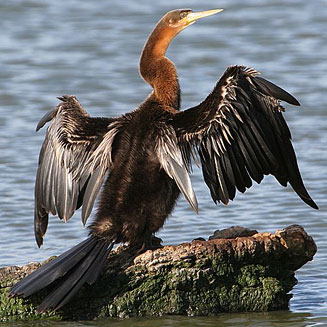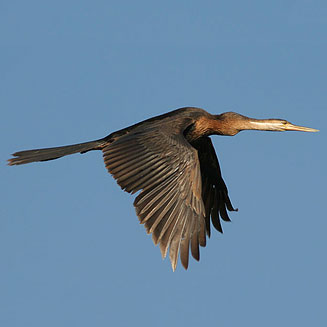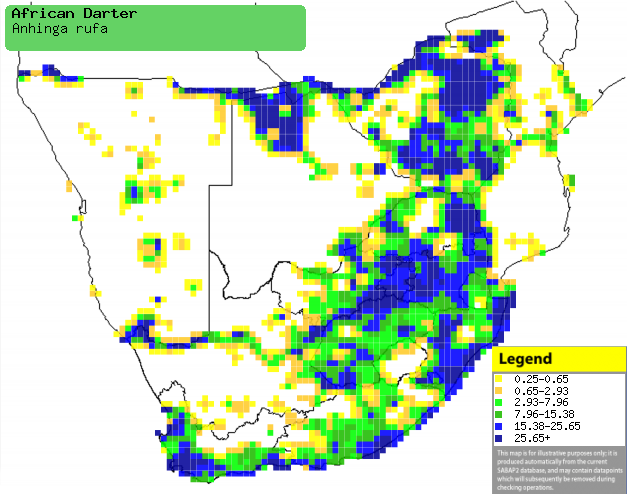Anhinga rufa
(African darter)
SlanghalsvoŽl [Afrikaans]; Ivuzi
[Xhosa]; Endeda [Kwangali]; Timeletsane-lalanoha [South Sotho]; Gororo, Nyakolwa
[Tsonga]; Afrikaanse slangenhalsvogel [Dutch]; Anhinga d'Afrique [French];
Schlangenhalsvogel [German]; Mergulh„o-serpente [Portuguese]
Life
> Eukaryotes >
Opisthokonta
> Metazoa (animals) >
Bilateria >
Deuterostomia > Chordata >
Craniata > Vertebrata (vertebrates) > Gnathostomata (jawed
vertebrates) > Teleostomi (teleost fish) > Osteichthyes (bony fish) > Class:
Sarcopterygii (lobe-finned
fish) > Stegocephalia (terrestrial
vertebrates) > Tetrapoda
(four-legged vertebrates) > Reptiliomorpha > Amniota >
Reptilia (reptiles) >
Romeriida > Diapsida > Archosauromorpha > Archosauria >
Dinosauria
(dinosaurs) > Saurischia > Theropoda (bipedal predatory dinosaurs) >
Coelurosauria > Maniraptora > Aves
(birds) > Order: Ciconiiformes >
Family: Anhingidae
 |
 |
|
African darter female, Paarl Bird Sanctuary, South
Africa. [photo Trevor Hardaker ©] |
African darter male in non-breeding plumage, Paarl
Bird Sanctuary, South Africa. [photo Trevor Hardaker ©] |
Distribution and habitat
Occurs in patches across sub-Saharan Africa; in southern
Africa it is fairly common in
Zimbabwe, northern and eastern Botswana, South Africa and patches of Namibia and
Mozambique. It generally favours still or slow-moving bodies of freshwater,
especially with dead trees, rocks or banks where it can rest. It is rarely found
in fast-moving rivers, estuaries and coastal lagoons.
|
 |
|
Distribution of African darter in southern Africa,
based on statistical smoothing of the records from first SA Bird Atlas
Project (©
Animal Demography unit, University of
Cape Town; smoothing by Birgit Erni and Francesca Little). Colours range
from dark blue (most common) through to yellow (least common).
See here for the latest distribution
from the SABAP2. |
Predators and parasites
- Predators of chicks
- Predators of adults
- Parasites
- Pasteurella anatipestifer (a pathogen of ducks which causes
septicemia)
Movements and migrations
Little known, but it is thought to be a mainly
sedentary, occasionally moving in response to a problem with a
wetland, such as a decrease in food availability.
Food
It eats fish, using its webbed feet to dive underwater
before stabbing the fish with its bill. It swims more slowly than cormorants,
but
it compensates by being more stealthy, gliding through the water with just its
neck showing and barely producing a ripple. Its feathers are much more water
absorbent than most water birds, making it less buoyant and prone to death by
cold. It combats this by drying itself after foraging, spreading its wings in
the sun. It sometimes hangs motionless in the water, ambushing the fish
then coming to the surface to toss it in the air and swallow. The prey may be
lost in the process of this manoeuvre: in one case the caught fish was just to
large, so after struggling for 30 minutes to swallow it gave up. The following food items have been recorded
in its diet:
- Fish
- Pseudocrenilabrus philander (Southern mouthbrooder)
- Pharyngochromis acuticeps (Zambezi river bream)
- Oreochromus mortimeri (Kariba tilapia)
- Tilapia rendalli (Redbreast tilapia)
- Brycinus lateralis (Astriped robber)
- Hydrocynus vittatus (Tigerfish)
- Hippopotamyrus discorhynchus (Zambezi parrotfish)
- Barbus anoplus (Chubbyhead barb)
- Salmo trutta (Brown trout)
Breeding
- Monogamous and usually colonial, joining other water birds such as
White-breasted and
Reed
cormorants, African
spoonbill and herons in colonies of
10-50 pairs.
- The nest is built by both sexes in just a day or so, consisting of an
untidy platform of sticks or dead reeds, with a shallow cup in the centre
which is lined with grass. It is typically placed in a tree fork over water,
or alternatively in a reedbed.
- Egg-laying season is year-round, peaking from August-October in the
Western Cape but from October-December elsewhere.
- It lays 2-7 eggs, which are incubated by both sexes for roughly 22 days.
- The chicks are fed by both parents, leaving the nest after about 5-6
weeks, although they may drop into the water earlier if disturbed; they take
their first flight at roughly seven weeks old.
Threats
Not threatened.
References
-
Hockey PAR, Dean WRJ and Ryan PG 2005. Roberts
- Birds of southern Africa, VIIth ed. The Trustees of the John Voelcker
Bird Book Fund, Cape Town.
|
